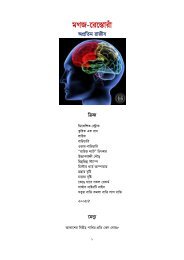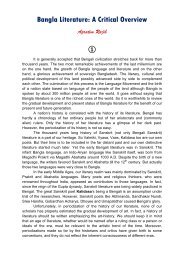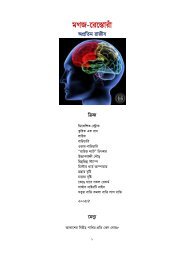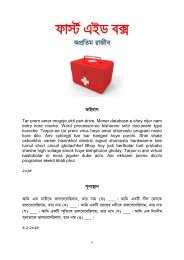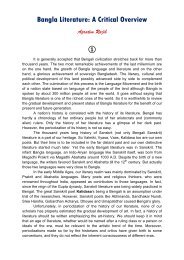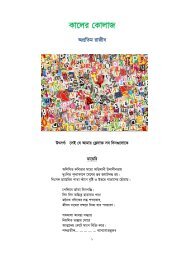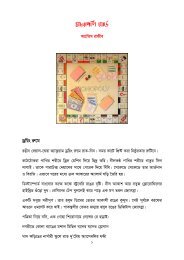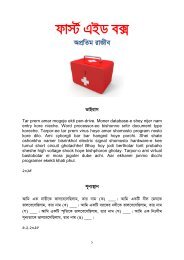BLiterature-Apratim
You also want an ePaper? Increase the reach of your titles
YUMPU automatically turns print PDFs into web optimized ePapers that Google loves.
9<br />
slowly merging. Even after the Battle of Plassey and Bengal’s subjection by the<br />
British East India Company (1757), the practice of Persian was still widening.<br />
Faced before the collision of two different foreign races, social stability and<br />
peace were much disturbed. Aesthetic joy and pleasure were fading and emotion<br />
and simplicity took their place. Appreciation of sublime poetry perished and linear<br />
literature and simple outlook replaced it.<br />
Artificial, sentimental and erotically perverse works were written throughout<br />
the period. One of the patrons was Raja Krishnachandra Ray (1710-’82) of Nadiya.<br />
His court-poet Bharatchandra Ray (1712?-’60) wrote the pornographic work Bidya-<br />
Sundar that has ornamental perfection but morally and philosophically is of little<br />
worth.<br />
Ali Raja was a Sufi poet. He expressed his religious ideas in his poems.<br />
Ramprasad Sen (1720?-’81) and Kamalakanta Vattacharya wrote Sakta<br />
Padas (devotional songs addressed to Goddess Kali) that have superfluous<br />
simplicity and emotional outburst.<br />
Rameswar Vattacharya composed Shiv-Mangal and Ghanaram Chakraborty<br />
wrote Dharma-Mangal. Their works too are not free of artificiality.<br />
Even vulgar folk tales were made around a person (historical or imaginary?)<br />
named Gopal Bhar. And Kavi and obscene Kheur songs too were written in many<br />
areas.<br />
Those poetasters actually brought an end to medieval Bengali culture, which<br />
was waiting to revive in a new era of an entirely different environment.<br />
The Scholastic Age (1801-’58)<br />
The British occupied Bengal in 1757. Gradually the entire India became their<br />
colony. As the Turkic invasion of the 13 th century had introduced a new age, the<br />
British occupation brought an amazing change on the life, culture, economy, art and<br />
literature of the nation. Western thoughts and culture began to enter the nation’s<br />
mind; the biggest impact was on its literature. Thus the cultural and cognitive<br />
movement called Bengal Renaissance occurred around the 19 th century. A new age<br />
started for Bengal and marked the beginning of modern Bangla literature.<br />
Our modern literature began its journey in the early 19 th century.<br />
Rediscovering and reshaping were two principal ideologies of the early modern era.<br />
It was the age of the Christian missionaries, the British orientalists, the Brahmo<br />
Samaj, the Young Bengal – the age of Jones, Carey, Rammohun, Derozio,<br />
Vidyasagar and other reformers. The orientalist scholars of the Asiatic Society [e.g.<br />
William Jones (1746-’94)] first sowed the seed of Renaissance by rediscovering<br />
history and literature of the pre-Islamic era. Rammohun introduced the monotheistic<br />
Brahmo movement. Then Derozio advanced the trend of progression further toward<br />
enlightenment based on reason.<br />
It was primarily an age of prose, and of academic books; most of the writers<br />
wrote for scholastic purpose. Bangla prose came into being through translations of<br />
foreign literary works by some scholars, most of whom were associated with the Fort




